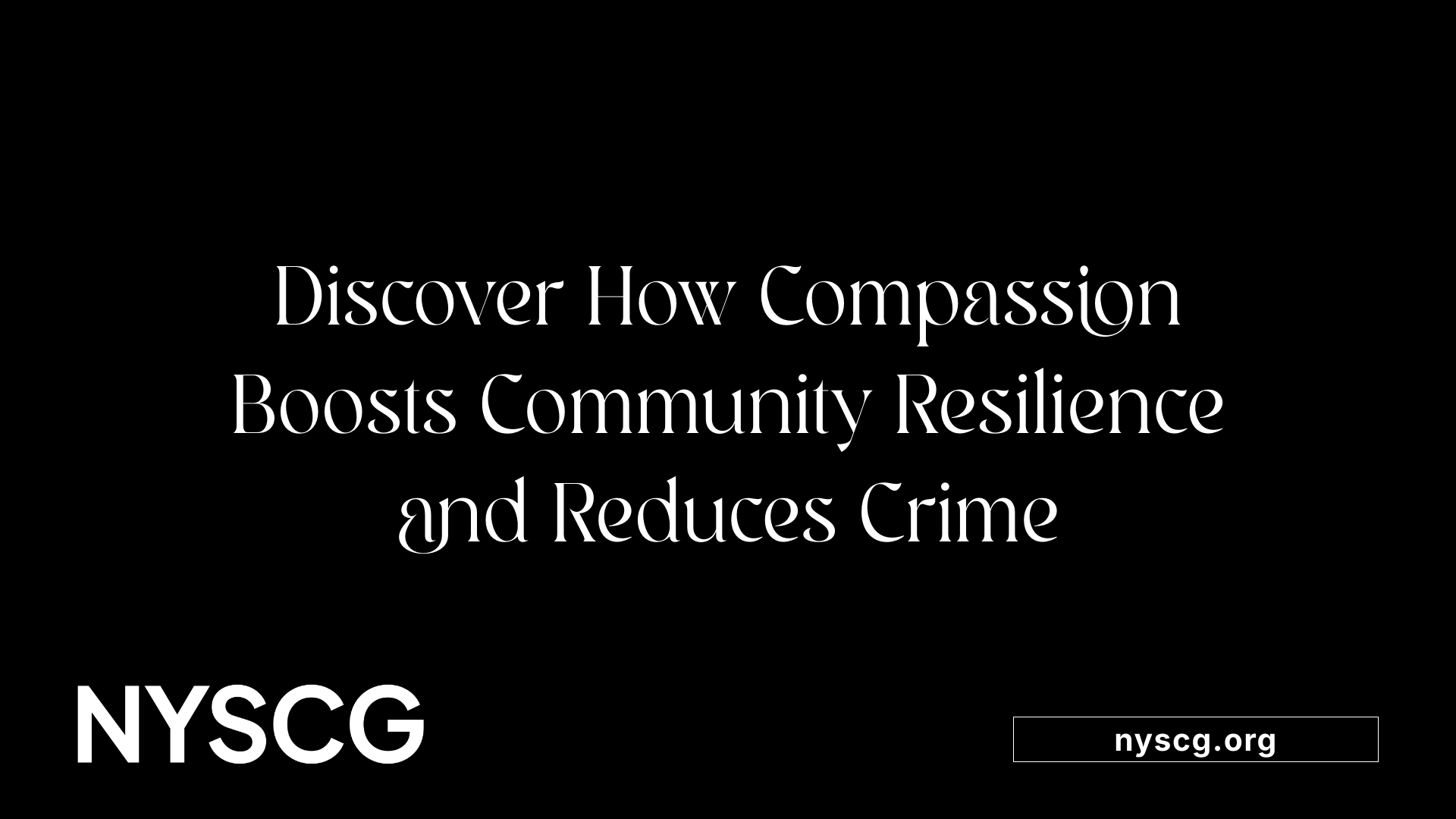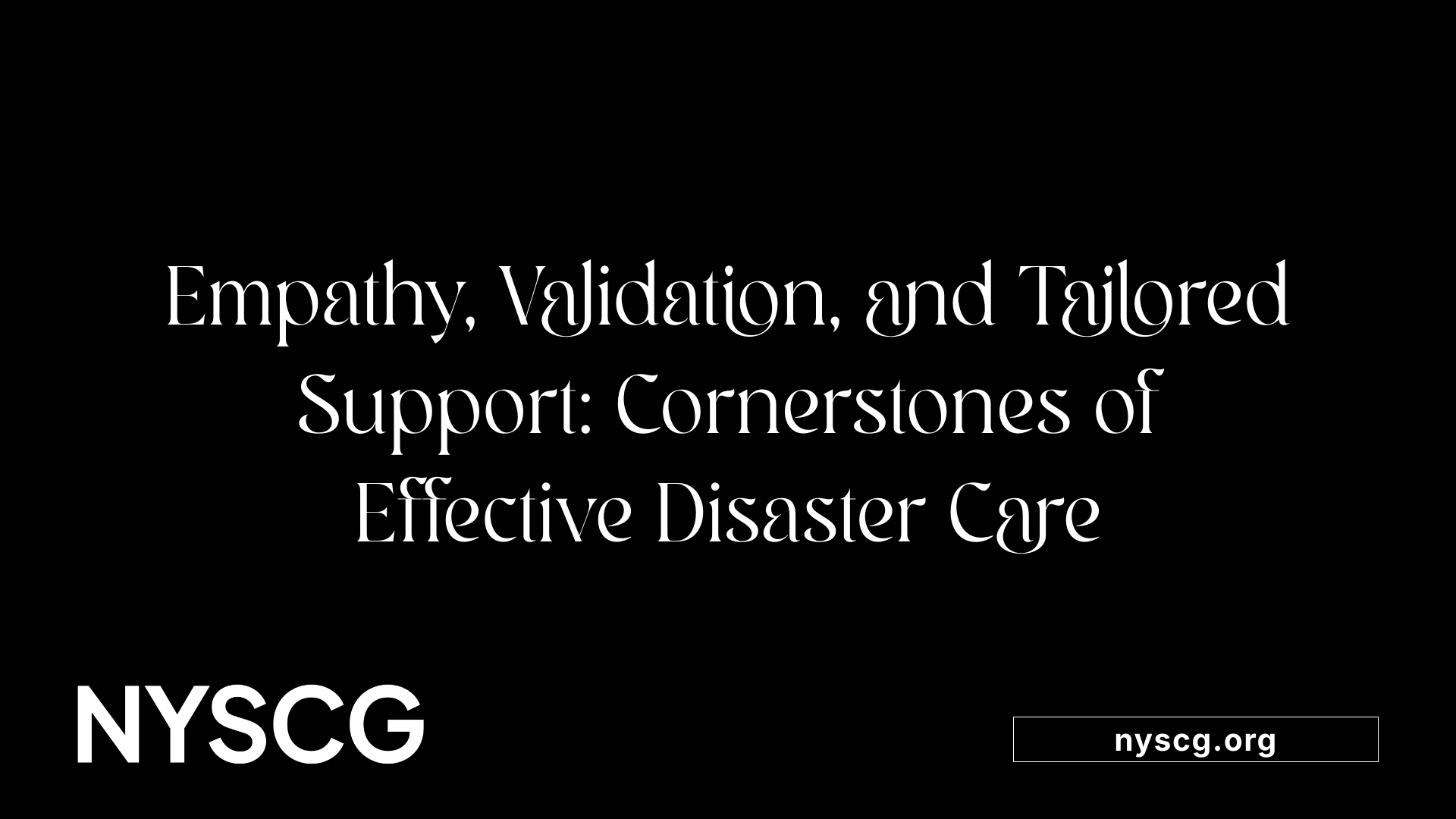Responding to Natural Disaster Survivors with Compassion


Natural disasters challenge communities and responders alike, often eliciting a spectrum of emotional reactions and behaviors. The way we respond—with compassion and prosocial behavior—can profoundly influence recovery. By exploring research findings, best practices, and trauma-informed approaches, we can develop effective, empathetic strategies to support survivors, foster resilience, and promote healing.
In disaster situations, compassion and prosocial actions are crucial in creating a foundation for recovery and community resilience. Rather than chaos or increased crime, research indicates that disasters often inspire kindness, cooperation, and mutual aid among survivors and unaffected individuals.
Compassion involves recognizing the suffering of others, feeling empathy, and taking deliberate actions to alleviate their distress. Prosocial behaviors—such as volunteering, donating, and offering emotional support—are driven by a shared sense of community and social identity, especially when strangers unite over a common fate.
Empirical studies reveal that these compassionate responses not only provide immediate relief but also foster long-term community cohesion. Acts of kindness—like helping neighbors, participating in rescue efforts, or providing emotional comfort—appear to increase happiness and reduce stress among helpers as well.
Despite media portrayals of panic and disorder, the reality shows that most people act altruistically after disasters. This collective response enhances recovery efforts, helps victims regain a sense of safety, and promotes healing among communities.
Compassion in disaster settings has three fundamental components:
During chaotic and overwhelming circumstances, maintaining these elements can be challenging but is essential. Effective compassion also requires self-awareness, humility, and reflection from responders to avoid condescension or burnout.
The positive effects of prosocial behavior are well-documented. Survivors often report increased community solidarity and mutual aid following disasters. These acts strengthen social bonds and promote resilience, which is vital for emotional and physical recovery.
Furthermore, acts of kindness can mitigate traumatic stress reactions such as anxiety and depression. The support network created through compassionate acts helps individuals process their trauma and regain a sense of control.
For communities as a whole, prosocial responses early in disaster recovery can accelerate rebuilding efforts and foster a shared identity that withstands future challenges.
While compassion is widely valued, some critiques highlight potential pitfalls. Misconceptions include views that compassion could be condescending, self-serving, or overly emotional.
Critics emphasize the importance of self-awareness and humility in compassionate acts, warning against paternalism or emotional fatigue.
Advocates argue that developing mature compassion involves ongoing self-reflection, understanding others’ needs, and broadening one’s capacity for empathy beyond immediate circles.
Organizations like WHO and the Center for Engaged Compassion advocate for integrating compassionate practices into disaster response and health policies, recognizing their role in healing and resilience.
Through these efforts, it becomes evident that genuine compassion and prosocial behaviors significantly improve disaster response outcomes, helping individuals and communities recover more effectively.
| Aspect | Description | Additional Notes |
|---|---|---|
| Importance | Foster immediate relief, promote community rebuilding | Enhances resilience and emotional healing |
| Elements | Recognition, empathy, action | Vital for effective compassionate response |
| Impact on Victims | Increased community cohesion, reduced stress, better psychological recovery | Acts as a buffer against trauma |
| Critiques and Misconceptions | Potential condescension, emotional overload, self-serving behaviors | Emphasizes humility, self-awareness, and broadening compassion |
| Examples of Actions | Rescue, aid, presence, emotional support | Physical and emotional aid are both crucial |

Scientific studies and observations from multiple sources show that disasters often trigger a surge in prosocial behaviors. Instead of chaos and crime, communities display increased kindness, cooperation, and altruism. For example, research published in the International Journal of Mass Emergencies and Disasters in 2009 found that natural disasters tend to decrease most types of criminal activity, highlighting a focus on community support rather than conflict.
Furthermore, a study published in Natural Hazards observed that charitable donations usually increase from outside the affected area, and community cohesion tends to be preserved or even strengthened after a disaster. Survivors often report acts of mutual aid, kindness, and a sense of solidarity, which emerge despite the overwhelming circumstances.
A prominent concept introduced by psychologist Jamil Zaki is 'catastrophe compassion,' describing widespread altruism and solidarity in response to crises such as earthquakes, pandemics, and terrorist attacks. This compassion involves three elements: awareness of suffering, emotional resonance, and action to alleviate distress.
The benefits gained by helpers are significant. Engaging in prosocial behavior during disasters boosts happiness and reduces stress and loneliness. This suggests that compassion not only aids those in need but also fosters positive mental states among helpers.
However, disasters present challenges to compassion. The chaos, confusion, and personal empathic overload can hinder effective response. Compassionate actions—whether physical like rescue or emotional like presence—are vital but can be impeded if responders are overwhelmed.
To harness the positive aspects of compassion, developing mature compassion through self-awareness, critical reflection, and humility is essential. Training and organizational support also improve responders' capacity to act effectively and sustainably.
In summary, empirical evidence underscores that compassion in disasters does more than promote community resilience; it actively reduces crime, fosters cooperation, and benefits both survivors and helpers alike. Recognizing and cultivating these compassionate responses are crucial for effective disaster management.

Effective disaster response goes beyond physical aid; it involves compassionate human interaction that fosters trust, safety, and emotional healing. One of the foundational practices is active listening, where responders attentively hear and acknowledge what survivors express about their needs and feelings. Demonstrating genuine empathy through verbal and non-verbal communication reassures survivors that they are not alone in their distress.
Validation of survivors' experiences is equally critical. Recognizing their pain and difficulties helps build rapport and encourages openness. Responders should remain emotionally aware, managing their own feelings to avoid burnout and compassion fatigue. Techniques such as self-care routines, peer support, and reflective practices are vital for maintaining emotional resilience.
Providing care that is trauma-informed and tailored to specific groups, like children or the elderly, ensures that interventions are sensitive to their unique vulnerabilities. Calm, clear, and context-appropriate actions, such as physical aid combined with emotional support, help meet immediate needs while fostering long-term recovery.
Organizational support enhances responder well-being and effectiveness. Creating a culture that values compassion satisfaction—where team members find meaning and fulfillment in helping—encourages sustained humane efforts. Additionally, training in trauma responsiveness and compassionate care equips responders with skills to handle complex emotional reactions and deliver appropriate support.
In summary, adopting practices that include active listening, empathetic validation, self-regulation, trauma-informed approaches, and organizational support form the backbone of compassionate disaster response. These strategies ensure that survivors feel supported and understood, facilitating better recovery outcomes.
 Are there educational resources or guidelines for compassionate communication and support in disaster contexts? Yes, numerous resources exist to guide responders, healthcare providers, and community leaders in delivering compassionate care during disasters. Organizations such as the Substance Abuse and Mental Health Services Administration (SAMHSA), the American Academy of Pediatrics (AAP), and the Red Cross provide extensive training materials, guidelines, and toolkits.
Are there educational resources or guidelines for compassionate communication and support in disaster contexts? Yes, numerous resources exist to guide responders, healthcare providers, and community leaders in delivering compassionate care during disasters. Organizations such as the Substance Abuse and Mental Health Services Administration (SAMHSA), the American Academy of Pediatrics (AAP), and the Red Cross provide extensive training materials, guidelines, and toolkits.
These materials cover a broad range of essential topics, including trauma-informed approaches, effective communication techniques, and psychosocial support strategies. For example, they include protocols for Psychological First Aid (PFA), a widely recognized method designed to help individuals regain a sense of safety, connect with social support, and manage distress. PFA emphasizes listening with empathy, providing practical assistance, and addressing basic needs, which is crucial in helping children, families, and responders cope.
Furthermore, these resources offer guidance tailored to vulnerable groups such as children and trauma survivors, as well as strategies for supporting disaster responders’ mental health. They highlight the importance of addressing resilience, fostering community cohesion, and promoting mental well-being as part of an effective disaster response.
Training opportunities are frequently available through online courses, workshops, and dissemination events organized by these institutions. These initiatives aim to expand understanding of trauma responses, teach self-care practices for responders, and promote broader adoption of compassionate communication principles.
In summary, trusted organizations provide comprehensive, accessible resources designed to enhance the capacity for empathetic, effective support during and after disasters. Using these materials helps ensure that responses are not only efficient but also sensitive to the emotional and psychological needs of affected populations, supporting faster recovery and long-term resilience.
Natural disasters often evoke intense feelings of fear, distress, and helplessness among survivors. Managing these emotional reactions with compassion plays a crucial role in aiding recovery and resilience. A fundamental approach involves active listening combined with empathy. When support providers listen attentively, acknowledge the survivor’s feelings, and avoid dismissive statements, they create a safe space for emotional expression.
Validating feelings is essential. Recognizing that grief, anger, or anxiety are normal responses to trauma helps individuals feel understood and less isolated. Cultivating compassion requires deliberate effort to stay present, mindful, and patient. Practices such as mindfulness exercises and compassion-focused activities can help both survivors and helpers ground themselves in their own experiences while fostering a caring attitude towards others.
Transforming intense emotions like rage or despair into understanding can be achieved through empathetic communication and emotional processing. Therapists and community workers can support this process by encouraging individuals to explore their underlying needs and desires, promoting self-compassion and patience.
Supporting emotional resilience involves creating environments where people feel safe to express their feelings and receive support. It also includes normalizing the emotional reactions to disaster, reducing stigma, and promoting collective understanding.
Building supportive communities that emphasize kindness, understanding, and mutual aid can significantly alleviate suffering. Interventions such as group discussions, emotional expression activities, and mindfulness exercises foster a culture of compassion, ultimately helping individuals regain control and foster healing.
In summary, managing disaster-related emotional responses with compassion hinges on empathetic listening, validating feelings, promoting mindfulness, and providing supportive contexts. These practices help transform intense emotions, reduce destructive anger or despair, and strengthen community resilience, forming a foundation for long-term recovery and mental health.
Supporting survivors of natural disasters through trauma-informed methods involves a comprehensive understanding of trauma symptoms that individuals and communities may experience. Recognizing signs such as hyperarousal, intrusive memories, emotional numbing, and prolonged distress helps responders create a sensitive and respectful environment.
A fundamental principle is ensuring the safety of those affected by the disaster. This means establishing physical safety through secure environments and emotional safety by fostering trust, transparency, and respect in interactions.
Empowerment and community engagement are vital. Providing survivors and community members with information about trauma effects educates them and helps mitigate feelings of helplessness. This support encourages active participation in recovery efforts, reinforcing their sense of control.
Psychosocial interventions like Psychological First Aid (PFA) are crucial early steps, offering immediate emotional support by helping survivors feel safe, regain control, and connect with support networks. Skills for Psychological Recovery (SPR) expands on this, offering coping strategies for those experiencing ongoing distress.
For individuals with more severe trauma reactions, evidence-based therapies such as trauma-focused cognitive-behavioral therapy (CBT) and Eye Movement Desensitization and Reprocessing (EMDR) are recommended. These therapies help process traumatic memories and reduce symptoms effectively.
Education about trauma effects benefits all stakeholders involved in recovery—including healthcare workers, volunteers, and community leaders—enhancing collective understanding and response capacity.
Applying trauma-informed principles fosters a healing environment where communities can recover more resiliently. This approach not only addresses immediate mental health needs but also promotes long-term resilience and collective well-being, allowing communities to 'bounce forward' from adversity.
Providing effective and compassionate support to those impacted by disasters requires a combination of respectful communication, emotional validation, and connection to resources. First, it’s crucial to engage in empathetic dialogue by choosing appropriate moments and safe environments to communicate. Listening actively and reflecting on survivors’ feelings without judgment helps them feel heard and understood.
Offering reassurance is equally important. Simple statements like "I can see this is very difficult for you" or "You’re not alone in this" foster trust and comfort. Recognizing their distress through supportive comments validates their experiences and helps lessen feelings of helplessness.
Supporting emotional expression and social connectivity can significantly aid recovery. Regular check-ins, encouraging survivors to share their feelings, and supporting healthy routines can reduce isolation. Facilitating opportunities for survivors to connect with friends, family, or support groups sustains social bonds that are vital during recovery.
Connecting individuals to community resources, mental health services, or counseling is an essential step if distress persists. Referring survivors to professional help or community organizations provides ongoing support tailored to their needs.
Above all, showing genuine interest, practicing patience, and respecting survivors’ dignity and personal experiences are vital. Creating a nonjudgmental, safe space for survivors to express themselves fosters trust and promotes healing. Compassionate care involves understanding, patience, and a commitment to supporting recovery, illustrating that compassion and empathy are central to disaster response.
| Strategy | Purpose | Implementation Tips |
|---|---|---|
| Empathetic dialogue | Make survivors feel heard and supported | Use reflective comments and active listening |
| Reassurance and acknowledgment | Reduce feelings of isolation | Validate feelings with simple, genuine statements |
| Emotional support | Encourage expression and social bonds | Promote routines and facilitate social interactions |
| Connecting to resources | Ensure ongoing mental health care | Provide clear information and referrals |
| Respect and dignity | Build trust and foster safety | Avoid judgment, maintain confidentiality |
Implementing these strategies effectively can significantly improve the emotional well-being of disaster survivors, helping them navigate through trauma towards recovery.

Supporting mental health and emotional recovery for disaster survivors involves multiple strategies that ensure accessible help and emotional stabilization. One of the most effective measures is providing immediate access to counseling services, such as helplines like the Disaster Distress Helpline, which offers round-the-clock support.
Normalizing common emotional reactions plays a crucial role in recovery. Survivors often experience feelings like sadness, anxiety, trouble sleeping, or irritability. Recognizing these reactions as normal responses to trauma helps reduce feelings of shame or isolation.
Encouraging self-care routines is essential. Routine activities such as maintaining regular sleep schedules, eating healthy foods, engaging in physical activity, and practicing relaxation techniques support emotional resilience. These practices help manage stress and prevent long-term mental health issues.
Children need special attention. Providing age-appropriate support and opportunities to talk about their feelings helps them process trauma. Adults can help by offering reassurance, maintaining routines, and creating a safe environment for children to express their fears.
Fostering social connections and hope contributes significantly to recovery. Encouraging survivors to connect with family, friends, or support groups facilitates emotional bonding and shared resilience. Community cohesion and mutual aid activities reinforce a sense of belonging and purpose.
Monitoring for persistent symptoms is vital. Those with ongoing issues like severe depression, post-traumatic stress disorder (PTSD), or substance misuse should be referred to mental health professionals for specialized care. Recognizing warning signs early allows for timely intervention.
Resources such as psychoeducational materials, support groups, and therapy referrals can be incredibly helpful. Overall, addressing immediate emotional needs while providing long-term support can greatly improve recovery prospects. Maintaining hope, patience, and community support encourages resilience and helps survivors rebuild their lives beyond trauma.
Effective disaster response that incorporates compassion, empathy, and trauma-informed care not only alleviates immediate suffering but also cultivates resilience within individuals and communities. Recognizing the innate prosocial response triggered by disasters, and supporting it with best practices, education, and organizational commitment, empowers survivors and helpers alike. As we reinforce the importance of genuine compassion—grounded in self-awareness and cultural sensitivity—we lay the foundation for more humane, effective, and sustainable disaster management. Through kindness and understanding, communities can recover stronger and more united, embodying the true spirit of human solidarity.
All you need is the will to make the world a better place.
New York State chaplain group inc. is a tax deductible organization with a federal tax Id number 92-383-4921